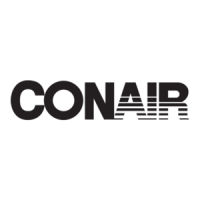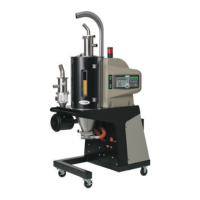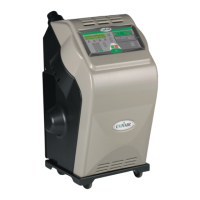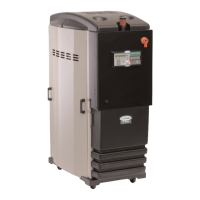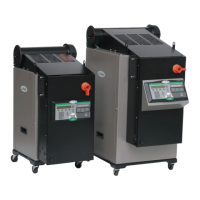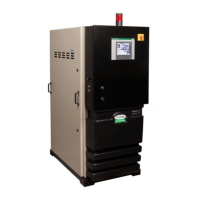
Do you have a question about the Conair Carousel Plus W Series and is the answer not in the manual?
| Type | Hair Dryer |
|---|---|
| Speed Settings | 2 |
| Heat Settings | 3 |
| Cool Shot Button | Yes |
| Ionic Conditioning | Yes |
| Concentrator Nozzle | Yes |
| Wattage | 1875 W |
Explains the manual's goal of guiding users through installation, operation, maintenance, and repair.
Details the use of symbols and structure to convey important safety and operational information.
Describes the manual's specific focus on the dryer's application as a central drying unit.
Outlines user obligations for safety, including reviewing guides, equipment, and procedures.
Highlights critical safety precautions to prevent hazards and injury during operation.
Provides step-by-step instructions for safely isolating equipment from power sources for maintenance.
Defines the dryer's function in removing moisture from plastics using a desiccant wheel and closed-loop system.
Lists common scenarios for dryer placement and use, including central and standalone configurations.
Explains the continuous drying process involving heaters, a desiccant wheel, and air circulation cycles.
Details technical data including model performance, dimensions, weight, voltage, and water requirements.
Describes optional features like volatile traps, precoolers, filter checks, and communication modules.
Guides users through the process of safely removing the dryer and its components from shipping containers.
Covers essential site preparations, including power sources, water supply, and clearance requirements.
Instructions for correctly placing the dryer near processing machinery for optimal hose connections.
Details the procedure for removing a securing tie from the desiccant wheel during installation.
Provides instructions for safely connecting electrical power, emphasizing lockout/tagout procedures.
Explains how to correctly install and connect the RTD probe for accurate drying air temperature monitoring.
Details the installation and connection procedure for the setback RTD probe at the hopper outlet.
Outlines steps to verify correct airflow direction and blower operation using the control panel.
Guides the connection of flexible hoses between the dryer and the hopper for air circulation.
Specifies hose connection sizes and notes the need for adapters if sizes differ between dryer and hopper.
Describes the process of installing air hose adapters, including gasket placement and securing with clamps.
Provides instructions for securing the aftercooler assembly and connecting water supply and discharge lines.
Refers to separate manuals for instructions on mounting loaders or vacuum receivers to the hopper.
Details steps to verify correct operation after installation, including checking blowers, heaters, and wheel rotation.
Directs users to the addendum for hardware installation and configuration of optional communication modules.
Introduces the initial Home screen displayed upon dryer power-up and its key information areas.
Explains the use of navigation buttons and magnifying glass icons for interacting with the DC-T control interface.
Provides a detailed overview of the DC-T screen elements and their functions, including data display and navigation buttons.
Describes dryer operation when configured for ResinWorks systems, involving multiple hoppers or central drying.
Illustrates the navigation paths and relationships between various control screens and functions.
Details the functionality of screens for ResinWorks systems, including overview, hopper selection, and individual hopper details.
Outlines dryer operation when configured for standalone use with internal delivery air heat for a single hopper.
Explains the operation of screens for standalone dryers, covering overview, detail, heater, and monitor functions.
Covers common operating procedures applicable to both standalone and ResinWorks dryer configurations.
Details the five customer security levels and procedures for logging in to access different system functionalities.
Provides step-by-step instructions for powering up and initiating dryer operation, including material loading and setpoint entry.
Explains how to modify temperature setpoints to optimize drying efficiency and material quality, with usage tips.
Describes the proper procedure for shutting down the dryer, including cooldown sequences and status indicators.
Explains the meaning of the PWR, CF, and ALM LED indicators on the DC-T control for system status.
Covers setup for email/text alarms, Ethernet configuration, address management, and notification controls.
Details DC-T web access logon procedures and web server setup for enhanced security.
Provides a schedule of recommended tasks for routine maintenance to ensure optimal dryer performance.
Outlines procedures for monitoring dryer dewpoint performance using a portable instrument.
Details the process for draining and cleaning the dryer hopper and spreader cone between material changes.
Provides step-by-step instructions for removing, cleaning, and reinstalling the process air filter.
Guides users through the process of cleaning or replacing the regeneration filter to maintain airflow efficiency.
Explains how to safely clean the aftercooler coils to maintain efficient operation, including water flow checks.
Details the procedure for cleaning the optional precooler coils to ensure efficient performance.
Provides instructions for removing, cleaning, and reinstalling the volatile demister cover and assembly.
Covers the importance of checking hoses and gaskets for damage or looseness to prevent moisture ingress.
Describes how to clean the touch screen display safely to ensure visibility and proper operation.
Advises on initial steps before troubleshooting, including checking alarms, diagrams, and prior procedures.
Emphasizes safety warnings, including the need for qualified personnel and lockout procedures for electrical work.
Guides users on interpreting alarm messages and using the alarm log to diagnose issues.
Lists potential problems causing automatic dryer shutdown, their possible causes, and corresponding solutions.
Describes alarms that indicate issues preventing correct drying but do not cause immediate shutdown, with troubleshooting steps.
Covers less common messages and alarms that might indicate control system or communication problems.
Addresses issues related to the dryer not achieving the desired dewpoint, with potential causes and solutions.
Helps diagnose problems potentially caused by incorrect drying temperature, residence time, airflow, or dewpoint.
Provides instructions for safely checking and replacing blown fuses, emphasizing lockout and proper fuse type.
Details the process of testing heater solid-state relays using an ohmmeter for continuity.
Explains how to check RTD sensor positions, conditions, and resistance for accurate temperature readings.
Guides users through the replacement of regeneration and process heater tubes, including insulation and connections.
Provides a step-by-step procedure for safely removing and replacing the desiccant wheel assembly.
Details the process for replacing the desiccant wheel motor, including belt tensioning and alignment.
Introduces Conair's customer support services and the availability of sales representatives.
Provides contact information for Conair customer service, including phone numbers and hours of operation.
Lists essential information and checks a user should perform before contacting customer service for assistance.
Outlines the terms and conditions of Conair's guarantee against defects in material and workmanship.
Details Conair's warranty regarding equipment performance levels as stated in quotations or specifications.
Disclaims other warranties, express or implied, beyond the stated equipment guarantee and performance warranty.
Provides instructions for installing an optional precooler assembly, including water connections and housing.
Lists Modbus registers, data points, types, access levels, and ranges for the DC-T control system.
